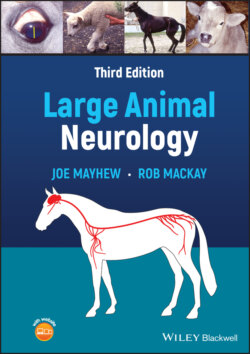Читать книгу Large Animal Neurology - Joe Mayhew - Страница 75
Gross artifacts
ОглавлениеVertebral and cranial fractures and separations sometimes occur at the time of euthanasia and during any manipulation of the cadaver of both immature and heavy large animals. This may be the result of falling, electrocution, dragging, and slinging. Surprisingly, considerable hemorrhage may be present around such fracture sites, and the histologic appearance can be difficult to interpret. Irrespective of this, large, mainly subarachnoid, spinal and cranial hemorrhages also occur, especially if decapitation is performed immediately after death.
Gross estimates of an excessive (or deficient) volume of CSF are almost impossible to make, and except for noting any other major malformation, the evaluation of an apparent slight increase in the size of ventricles should await measurements made after fixation.
Areas of postmortem damage to nervous tissue can appear as a softening (malacia) and discoloration. Saw cuts and sites of tension may be apparent, but the spinal cord in particular must be removed carefully to avoid an effect akin to squirting toothpaste from a tube; tension or compression on the spinal cord within its dura mater easily causes constrictions, areas of softening, discoloration, and dislocation of parts of spinal cord tissue.
Figure 4.2 With the vertebral column cut into cervical, cranial thoracic, and thoracolumbosacral sections, a laminectomy may be performed to remove the spinal cord sections or a spinal cord removal instrument as shown can be used to gently cut the spinal nerves in the epidural space allowing withdrawal of the spinal cord segments. Such an instrument as shown at top is ~60–80 cm long and has a blunt‐ended, curved blade with indented cutting surface at one end (two close‐up views are shown beneath).
A common error in preserving large masses of neural tissue is underestimating the volume of aldehyde fixative to use resulting in autolysis of tissues and even bacterial growth in the cramped samples sitting in a small volume of fixative! A ratio of one‐part nervous tissue to ten parts fixative is ideal, and changing the fixative after 24 h is good practice and helps reduce any blood staining of the preserved specimens. Partial and differential fixation can produce localized changes in texture and color, so comment is best reserved until fixation is complete. This does not preclude initial sectioning of the brain and spinal cord, as this also aids in fixation.
